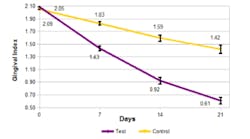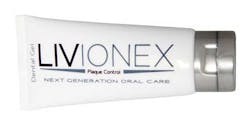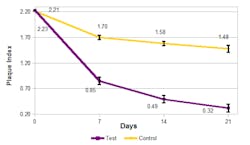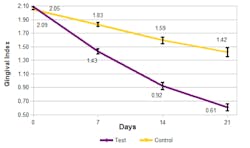Brushing up on 21st-century toothpaste technology
According to Gwen Essex, EdD, RDH, a new tooth gel on the market—Livionex—offers the first major advancement in toothpaste since the 1990s. Results from early clinical studies show the tooth gel to be effective in reducing plaque biofilm and gingival inflammation.
Considering that toothpaste is a medicament that a majority of dental patients use on a regular basis, it is surprising how infrequently there is a new approach to chemically add to the mechanical removal of plaque bacterial biofilm. The list of clinical enhancements to toothpaste, while short, boasts of some important heavyweights: (a) fluoride, responsible for a significant reduction in childhood caries; (b) pyrophosphate, shown to reduce the accumulation of calculus; and (c) triclosan, the most recent, shown to be efficacious in the treatment of gingivitis. Given that the last widely available toothpaste advancement entered the market in 1990s, the advent of a new tooth cleansing formula to combat clinical inflammation is big news that clinical hygienists and patients will welcome.
In randomized, blinded clinical studies, a new tooth gel has been shown to provide clinically significant reduction of plaque bacterial biofilm, gingival inflammation, and bleeding upon probing. (1–3) The early science is quite exciting.
Recent clinical studies have evaluated a proprietary formula containing the chelating agent activated edathamil against a readily available dentifrice containing triclosan that has previously shown clinical efficacy against bacterial plaque biofilm and gingival inflammation. As Figures 1–2 show, in each of the clinical studies, the test gel, Livionex, was shown to have superior efficacy in bacterial plaque biofilm reduction, gingival inflammation resolution, and elimination of bleeding upon probing. (1–3)
Figures 1–2: When compared to a dentifrice containing triclosan, Livionex tooth gel showed superior efficacy against bacterial plaque biofilm and gingival inflammation.
How does this new tooth gel formula aid in plaque removal? Livionex chemically targets the electrical attraction between dental pellicle and bacterial plaque, a bond that is mediated by calcium. Both the pellicle and plaque bacteria are negatively charged and are held in contact by the action of positively charged calcium molecules. Without the positive charge of the calcium attracting both the pellicle and plaque bacteria, the adherence of bacterial biofilm is greatly reduced. By interrupting the calcium-ion bridge, Livionex can significantly reduce the presence of bacterial plaque biofilm and subsequently the clinical indicators of gingival disease: gingival inflammation, as measured by the Loe and Silness index, and bleeding, as measured by a modified sulcus bleeding index and pocket depth. (1–3)
Who might benefit from the additional treatment effects of Livionex? Any patient suffering from gingival inflammation is a candidate, certainly, but it doesn’t necessarily end there. Consider the option of enhanced plaque control for any patient for whom daily mechanical plaque removal proves to be challenging. Livionex may be particularly useful for those who have yet to develop an interproximal cleaning regimen; in one of the early clinical studies, Livionex was shown to be effective even in the absence of other oral hygiene practices such as flossing. (3) That’s right—even without interproximal deplaquing, study patients randomized to the activated edathamil gel showed significant improvements over those who were assigned to triclosan gel. (3)
While mechanical plaque control is still a critical component of attaining and maintaining oral health, it seems we have come to a time where there is a bit more assistance available for those who cannot perform all of the ideal home care practices we might recommend. As you see patients living with gingival inflammation, don’t forget that there is a new approach to consider that can add an additional chemical aid to toothbrushing.
Editor's note: This article first appeared in Pearls for Your Practice: The Product Navigator.Click here to subscribe. Click here to submit a products article for consideration.
References
1. Cauller T. Livionex Dental Gel: A Molecular Level Redesign with Game-Changing Results. North Texas Dentistry. 5(2):12-13.
2. Ralston D, Carrasco R, Jacobsen P, Wink C. Comparison of Plaque Removal Capabilities between Two Dentifrices. Oral Hyg Health. 2014;2(5):157.
3. Dadkhah M, Chung NE, Ajdaharian J, Wink C, Klokkevold P, Wilder-Smith P. Effects of a Novel Dental Gel on Plaque and Gingivitis: A Comparative Study. Dentistry (Sunnyvale, Calif.). 2014;4(6):239-.




